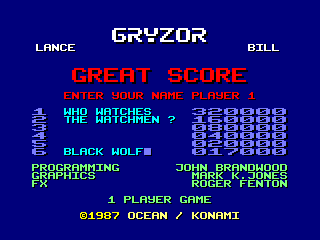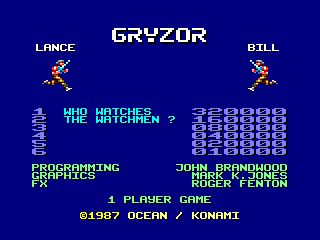Retro Replay Review
Gameplay
Contra delivers one of the purest run-and-gun experiences ever designed, dropping players into a relentless gauntlet of enemies, traps, and bosses. As one of the elite Contra operatives—Bill Rizer or Lance Bean—you’ll advance through each stage by blasting alien soldiers, mechanical contraptions, and grotesque extraterrestrial lifeforms with finger-on-the-trigger intensity. The core loop is simple: move forward, avoid incoming fire, pick up power-ups, and repeat until you reach the level’s climactic showdown.
The weapon upgrade system is a highlight, offering four distinct power-ups—such as the lethal spread shot, rapid-fire laser, and penetrating flame cannon—that fundamentally shift your approach to each stage. Timing your weapon switch is crucial; dropping the right upgrade before an ambush can mean the difference between a triumphant advance and an abrupt Game Over. For veteran players, mastering the spread shot’s arc pattern becomes a hallmark of skilled play, especially when paired with precise platforming movements.
Contra’s cooperative mode doubles the chaos and fun. Teaming up with a second player transforms each firefight into a carefully orchestrated dance of cross-screen cover fire and high-stakes coordination. However, the shared pool of lives and limited continues add a layer of strategy: will you push forward aggressively or hang back to conserve your collective resources? Though the AI-controlled partner in single-player mimics enemy patterns, it’s the human-versus-human synergy that truly elevates the run-and-gun thrill.
Platform differences slightly alter the challenge. The arcade original boasts 10 full-scrolling levels, while home ports range from six to nine stages and occasionally swap to flip-screen transitions. C64 owners contend with only six stages, ZX Spectrum and Amstrad users tackle seven, and DOS fans enjoy nine. Each version preserves the breakneck pacing but introduces unique quirks—such as altered hitboxes or screen-transition delays—that can affect moment-to-moment gameplay decisions.
Graphics
Contra’s graphics stand out for their vibrant color palette and sharp sprite work, especially on the arcade hardware. Each marine, alien grunt, and looming end-stage boss is rendered with distinct silhouettes that read clearly amid the onslaught. Backgrounds shift from jungle outposts to subterranean caves and hover-craft runways, keeping the visual scenery fresh even as bullets and explosions dominate the screen.
On home systems, graphical fidelity varies but rarely loses the original’s punch. The DOS port downscales the detailed backgrounds slightly, yet retains smooth sprite animations and dramatic visual effects. Commodore 64 and ZX Spectrum releases simplify certain details—monochrome sprites on the Spectrum, for instance—but preserve the essence of each environment. Even flip-screen versions manage to capture Contra’s sense of scale, offering crisp character sprites against solid, if static, paraphernalia.
Special effects, like screen-shaking explosions and cascading bullet trails, convey the massive firepower at your disposal. When the bosses emerge—towering alien war machines or serpentine bio-constructs—their size and animation frames feel appropriately imposing. Particle effects during power-up pickups remain a small but satisfying flourish across all versions, underscoring every upgrade’s tactical importance.
Despite its age, Contra’s visual design holds up remarkably well. The game balances readability and spectacle, ensuring that hectic encounters never become visually muddy. Whether you’re strafing through dense foliage or leaping between scaffolding, you always know where the danger is and where your next shot needs to land. For prospective buyers, this visual clarity translates into fair, competitive gameplay rather than cheap, unseen traps.
Story
Set in the year 2631, Contra opens with a meteorite crashing into the Galuga archipelago—an island located 20 km northeast of New Zealand. Two years later, the Red Falcon terrorist network has harnessed the meteor’s cosmic energy to prepare for an all-out alien invasion. The premise, though straightforward, lays the groundwork for a high-stakes military intervention that feels epic in scope despite minimal exposition.
You assume the role of either Bill Rizer (Player 1) or Lance Bean (Player 2), members of the Earth’s elite Contra unit. Charged with infiltrating Red Falcon’s strongholds, your mission unfolds across diverse terrains: jungle encampments, underwater tunnels, laser-fortified bunkers, and an ominous alien fortress. Each stage name and brief introductory line in the arcade cabinet’s attract mode paints a vivid snapshot of the unfolding conflict.
Contra’s narrative is delivered sparingly—through particle-screen blurbs, boss introductions, and the occasional interlude sequence. This design choice keeps the momentum brisk, letting the action speak for itself. While fans seeking deep character arcs or plot twists may find the story skeletal, the lean presentation complements the game’s breakneck pacing, allowing you to remain immersed in the firefight without lengthy cutscenes.
For players who cherish retro lore, the backdrop of an interstellar threat combined with 1980s military aesthetics delivers potent nostalgia. The names Bill and Lance conjure heroic archetypes, while Red Falcon’s alien tech adds a sci-fi flavor that feels both timeless and era-authentic. Ultimately, Contra’s story serves its purpose by contextualizing the relentless gunplay and giving each stage a tangible goal beyond mere enemy extermination.
Overall Experience
Contra remains a benchmark for challenging, rewarding action games. Its blend of precise platforming, frenetic shooting, and co-op camaraderie creates an experience that has endured for decades. New players should enter with patience: the learning curve is steep, and memorizing enemy patterns is essential. However, those willing to invest the time will find each successfully cleared stage immensely satisfying.
The game’s design excels in replay value. Multiple difficulty settings—or choosing between solo and cooperative play—significantly alter the experience. Hunting for high-score bonuses, perfecting run-and-gun speedruns, or simply reliving the nostalgic thrill with a friend keeps Contra fresh long after the final boss has fallen. Even the home-computer ports, despite trimmed stage counts, offer unique variations that encourage multiple playthroughs.
Purchasing Contra today means embracing its vintage challenge rather than expecting modern handholding. The limited continues, instant-death enemy hits, and lightning-fast firepower demand reflexes and strategic weapon management. If you relish games that test your skills and reward mastery, Contra delivers in spades. Its blend of vibrant pixel art, addictive weapon systems, and iconic two-player co-op make it a must-have for retro enthusiasts and action fans alike.
In summary, Contra stands as a pillar of run-and-gun design. Whether you opt for the arcade original or explore one of the many home-computer ports, you’ll encounter tightly crafted levels, memorable bosses, and weapon mechanics that feel gratifying even by today’s standards. For anyone building a classic games library or seeking a heartbeat-racing challenge, Contra remains a timeless purchase.
 Retro Replay Retro Replay gaming reviews, news, emulation, geek stuff and more!
Retro Replay Retro Replay gaming reviews, news, emulation, geek stuff and more!









Reviews
There are no reviews yet.